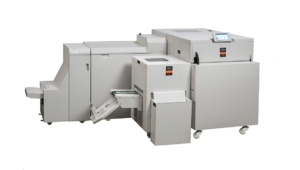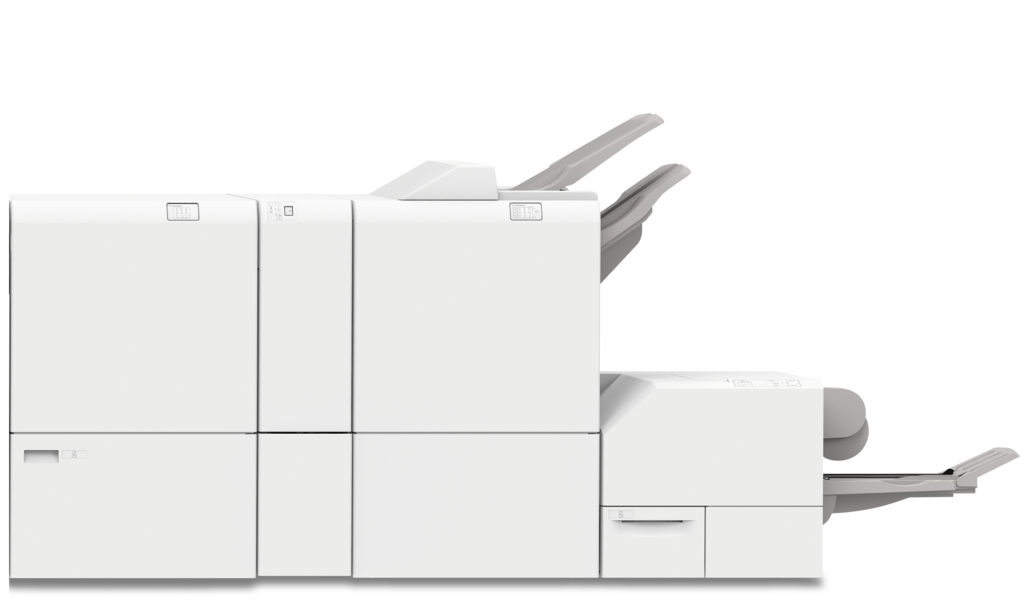Guest post by Fredrik Sandberg, Feeding & Finishing Business Manager, International Operations
Booklet making is one of the most common applications for digital presses, and each application is a unique story waiting to be told. Many booklet-making options are available for production presses, and it can be confusing to understand what’s best for your applications. To help, this blog will take you through a few of your choices.

Entry-level Booklet Makers
There are several Xerox options for smaller presses suited to smaller volumes and occasional entry-level booklet production. These units are cost-effective and produce good quality, but understand what you will need in terms of production volumes and number of sheets in a booklet. An entry-level choice might not work for your applications. You may need a different solution for advanced “story-making.” For example, the latest version of the Production-Ready Booklet Maker for the Versant and Iridesse presses is capable of up to 30 sheets and has optional modules for crease and bleed trimming, as well as a square fold option.
Booklet Makers for Higher Volumes
As production needs move up the spectrum into higher volumes and other criteria, a range of machinery from press vendors and third parties come into play.
Plockmatic
At the entry production segment, we find devices from Plockmatic. They have a modular system which has two base models, the Pro35 and the Pro50. In addition to these models there are modules for:
- Face trimming
- Square spine
- Cover feeder
- Rotating creaser trimmer
The possible combinations let customers step into various production environments. The Plockmatic systems connect to most Xerox printers in the entry production color and mono lines, as well as some other production systems.
Watkiss

For more demanding applications and higher volumes of stories, we have offerings from Watkiss. Watkiss provides us with two models: the PowerSquare 224 and PowerSquare 160. Both are compact devices with optional two-knife trimmer and book stacker. They contain all the main functions in a small footprint, making it a good option for organizations with space issues. They are robustly built to handle higher production volumes and have a unique construction that ensures the stitch/staples are always centered on the booklet spine. The PowerSquare 160 uses a staple mechanism and can handle up to 40 sheets, as well as a long-sheet capability to create landscape A4 booklets or other unique formats. The PowerSquare 224 handles up to 56 sheets for really thick booklets, and uses a single stitch-head with wire. This construction also lets the PowerSquare 224 place up to six stitches in the spine for extra assurance or for producing three-up of a smaller booklet.
C.P. Bourg
For the heaviest in-line production of stories, we have the booklet makers from C.P. Bourg: two entry models and a top model. All are suited for heavy production and can sustain high-volume booklet making. The C.P. Bourg BDFN entry device is simple, but robust. It’s lower cost as it has fewer features. The next device from CP Bourg, the BDFE, has a more flexible structure with bleed/crease devices, square edge module and job definition format (JDF) control. Both the BDFN and BDFE can handle large booklets up to 22 sheets. At the top of the C.P. Bourg booklet-making portfolio, we have the BME. This model is designed to be gentle with color prints and handle up to 30 sheets, while sustaining very high production levels. The BME can also take on large sheets for landscape A4 booklets, as well as the 364mm maximum width of the Xerox iGen press. On top of this, the BME uses the same options of bleed / crease devices and square edge modules as the BDFE unit.
Inline or Offline – Which Is Most Efficient?
Another important thing to consider as you evaluate booklet-making tools is the inline/offline question. You may be aware that Xerox pioneered a new development a few years ago – an inline sheet feeder from C.P. Bourg, the BSFE, but why even put a sheet feeder at the end of your printer? Well, with a sheet feeder at the end of the printer connected to the finisher, not only can you run the finishing device inline, you can also run it offline, hence creating a dual-mode configuration. It will even let you use the finishing capability for prints from another press and optimize all your “story-making” devices more efficiently. Inline operation tends to be most efficient for short runs and varying formats, and offline tends to work better for longer runs, but ultimately a dual-mode configuration can enable your production operation to run as efficiently as possible.

These are just some of your options for booklet making, and other Xerox partners such as Duplo, Horizon and Muller Martini also supply a range of devices. So how do you know which machine is right for all your stories waiting to be told? It’s a good discussion to have with your sales person. They can guide you to the booklet-making device that fit your needs the best.




[…] post Booklet Makers Turn Stacks of Pages into Beautiful Stories appeared first on Digital Printing Hot […]
I really like all these suggestions. Thanks for sharing such a fantastic post. Best Offset Printers in Mumbai. To get more information visit us: – http://www.pacificprints.in/